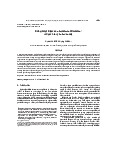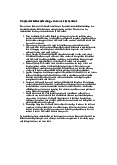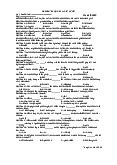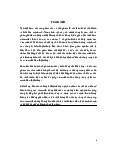








Preview text:
Consumer Behavior, Global Edition, 10e (Solomon)
Chapter 1 Buying, Having, and Being Multiple Choice
1) A marketer who segments a population by age and gender is using ________ to categorize consumers. A) demographics B) psychographics C) roles D) lifestyle
2) A consumer researcher who examines consumers' lifestyles and personalities is studying ________. A) demographics B) psychographics C) social class D) usage rates
3) In an online ________, members share opinions and recommendations about products. A) market segment B) consumption community C) marketing database D) culture jam
4) A marketer uses ________ to target a brand only to specific groups of consumers who are
most likely to be heavy users of the marketer's brand. A) asynchronous interactions
B) market segmentation strategies C) the 80/20 strategy D) economies of information
5) Which of the following is the study of the processes involved when individuals or groups
select, purchase, use, or dispose of products, services, ideas, or experiences to satisfy needs and desires? A) lifestyle marketing B) role theory C) consumer behavior D) marketing research
6) A(n) ________ is a person who identifies a need or desire, makes a purchase, and then disposes of a product. A) marketer B) consumer C) influencer D) content generator 1
Copyright © 2013 Pearson Education
7) According to the basic marketing concept, a firm exists to ________. A) influence culture B) dominate market share C) nurture relationships D) satisfy needs
8) Which of the following explains how a minority of a product's users make up a majority of sales of that product?
A) culture of participation theory B) the 80/20 rule C) positivism D) role theory
9) People who belong to the same social class are most likely to have which of the following in common? A) income level B) personality C) ethnicity D) family structure
10) Which of the following is NOT one of the three fastest-growing ethnic groups in the United States? A) African Americans B) Irish Americans C) Hispanic Americans D) Asian Americans
11) Which of the following marketing philosophies emphasizes interacting with customers on a
regular basis and giving them reasons to maintain a bond with a company's brands over time? A) differentiated marketing B) global marketing C) social marketing D) relationship marketing
12) Wal-Mart tracks the habits of the 100 million customers who visit its stores each week and
responds with products and services directed toward those customers' needs based on the
information collected. This is an example of ________ marketing. A) undifferentiated B) database C) relationship D) consumer-generated
13) The sociological perspective of ________ takes the view that much of consumer behavior resembles actions in a play. A) role theory B) pastiche C) interpretivism 2
Copyright © 2013 Pearson Education D) psychographics
14) A consumer with a(n) ________ attachment to a product uses the product as part of his or her daily routine. A) nostalgic B) interdependent C) psychographic D) positivist
15) Which of the following is an example of C2C e-commerce? A) RFID tags B) virtual brand communities C) database marketing D) green marketing
16) A digital native is someone who ________.
A) grew up in a "wired" and highly networked world
B) is a heavy user of alternate reality games (ARGs)
C) participates in database marketing
D) belongs to a consumption community
17) Which of the following terms refers to the online means of communication, conveyance, and
collaboration among interdependent and interconnected networks of people, communities, and organizations? A) open data partnership B) social media C) synchronous interaction D) asynchronous interaction
18) Which of the following is NOT closely associated with what your text terms the "horizontal revolution"? A) Web 1.0 B) Web 2.0 C) C2C e-commerce D) user-generated content
19) Rules of conduct based on universal values such as honesty, trustworthiness, and fairness that
guide actions in the marketplace are referred to as ________. A) social marketing policies B) consumer activism policies C) business norms D) business ethics
20) The term ________ refers to an environment in which an individual can dictate to a company
the type of products he or she wants and how, when, and where he or she wants to learn about them. A) database market 3
Copyright © 2013 Pearson Education B) consumerspace C) social market D) consumption community
21) A basic biological motive is called a ________. A) want B) demand C) need D) response
22) According to the ________ perspective, advertising is an important source of consumer information. A) consumerist B) database marketing C) transformative consumer D) economics of information
23) Which of the following is the government agency that polices advertising claims about edible products and pharmaceuticals?
A) the Food and Drug Administration
B) the Consumer Products Safety Commission
C) the Federal Trade Commission
D) the National Advertising Division
24) The National Advertising Division of the Council of Better Business Bureaus is an example of a(n) ________. A) federal agency B) social marketer C) industry watchdog D) culture jammer
25) Buy Nothing Day and TV Turnoff Week, events designed to discourage rampant
commercialism, are examples of ________. A) synchronous interactions B) economics of information C) green marketing D) culture jamming
26) The beginning of the modern era of consumerism is most closely associated with ________. A) Upton Sinclair B) Glenn Beck C) President Obama D) President Kennedy
27) Which of the following is NOT included in the "Declaration of Consumer Rights"? A) the right to safety B) the right to be informed 4
Copyright © 2013 Pearson Education C) the right to be guaranteed D) the right to choice
28) The goals of helping people and bringing about social change are the focus of ________. A) relationship marketing B) social media
C) Transformative Consumer Research D) Open Data Partnerships
29) Many firms choose to protect or enhance the natural environment as they go about their
business activities. This practice is known as ________. A) consumer marketing B) social marketing C) natural marketing D) green marketing
30) Researchers who argue that the field of consumer behavior should not be a "handmaiden to
business" believe that consumer behavior research should ________.
A) have a market-oriented focus
B) aim to apply knowledge to increasing profits
C) focus on understanding consumption for its own sake
D) be judged in terms of its ability to improve marketing practices
31) Which of the following social science fields would most likely be associated with macro consumer behavior? A) experimental psychology B) clinical psychology C) human ecology D) cultural anthropology
32) Which of the following social science fields would most likely be associated with micro consumer behavior? A) experimental psychology B) social psychology C) demographics D) cultural anthropology
33) Another term for positivism is ________. A) interpretivism B) pluralism C) modernism D) postmodernism
34) Of the following, a proponent of ________ would be most likely to argue that our society
emphasizes science and technology too much. A) consumerism B) positivism 5
Copyright © 2013 Pearson Education C) modernism D) interpretivism
35) A consumer researcher who believes in the paradigm of ________ believes that human
reason is supreme and that there is a single, objective truth that can be discovered by science. A) fundamentalism B) interpretivism C) positivism D) postmodernism
36) The belief that meaning is not fixed but is instead constructed by each individual is part of the ________ paradigm. A) positivist B) pragmatic C) interpretivist D) consumerist
37) A student of postmodernism is most likely to believe that the world in which we live is a(n)
________, or a mixture of images. A) alternate reality B) paradigm C) consumerspace D) pastiche
38) Jenny Rowlins is absolutely exhausted after her shopping trip to pick out a dress for her
sorority's formal event. The stores were crowded, and none of her favorite shops carried a dress
that she liked in her size. After spending hours at the mall, Jenny gave up and decided to order
her dress online and just return it if it wasn't exactly right. This decision took place in the
________ stage of Jenny's consumption process. A) prepurchase B) purchase C) postpurchase D) influence
39) A soft drink company decided to produce a cola drink with more caffeine than usual in hopes
of preventing current teen and early-twenties customers from shifting to coffee and tea drinks
after graduating from college. The company test-marketed this new product at a Midwestern
university. The company has segmented the market based on ________. A) psychographics B) lifestyle C) demographics D) usage rates
40) Professor Franklin had a time machine and traveled back to 1975. He told a 1975 marketing
class that in the future it would become popular among high school and college students to put
holes through various parts of their anatomy and to attach metal plugs and ornaments through
those holes. The students laughed at Professor Franklin and said they couldn't imagine that 6
Copyright © 2013 Pearson Education
anyone would do that to his or her own body. What aspect of consumer behavior did the students not understand?
A) They didn't understand the impact of popular culture in influencing consumers.
B) They didn't understand that lifestyle issues are more important than social class issues.
C) They didn't understand the meaning of consumption.
D) They didn't understand the importance of culture jamming.
41) Lucy Chang recently purchased a lovely ceramic bowl that featured a red dragon design.
When she thought about her purchase, she found that she really had no justification for buying
the bowl other than it reminded her of the bowls her mother used during evening meals when she
was a young child in Hong Kong. Which of the following types of relationships with a product
best explains the reason for Lucy's purchase of the dragon bowl? A) self-concept attachment B) nostalgic attachment C) interdependence D) cohort attachment
42) Evan does business in South America. He has mastered Spanish and many cultural norms,
but he still has problems with cultural differences in ethics. Many of the regulatory officials Evan
must deal with expect bribes. Evan solves this problem by bringing with him a number of
moderately priced watches. When an official admires his watch, Evan offers it to him or her as a
gift. Later he puts a new watch on his wrist. Evan's situation demonstrates that ________.
A) different cultures define ethical business behaviors differently
B) laws regulating business have become uniform because of the demands of a global economy
C) a small lapse of ethics is acceptable
D) universal values are the basis of business ethics
43) An advertisement for a national shampoo shows a plain woman using the product, then
transforming to a gorgeous woman with a new hairstyle, dressed in elegant clothes, waiting for
the "man of her dreams" to appear on her doorstep. This advertisement best illustrates which of
the following criticisms of the marketing system?
A) Marketing makes society overly materialistic. B) Marketers promise miracles. C) Marketers create needs.
D) Marketers control popular culture.
44) Morris Davis believes that advertising and marketing have too much impact on a consumer's
daily life. To fight this problem, Mr. Davis recently launched a Web site called "Junk It!" His
Web site invites disgruntled consumers to communicate with him about marketing invasions of
their privacy and individual space. Mr. Davis believes that change comes slowly but that
consumers must fight to preserve their culture and freedom from marketers and advertisers.
Which of the following terms best expresses the actions being taken by Mr. Davis to disrupt what
he perceives as inappropriate marketing and advertising actions? A) marketing myopia B) cultural symbolism C) culture jamming
D) transformative consumer research 7
Copyright © 2013 Pearson Education
45) George says that he sees everything as "black or white—no in between." George would most
accurately be characterized as a(n) ________. A) positivist B) collectivist C) interpretivist D) consumerist
46) Which of the following best characterizes social critic Vance Packard's position on the
possibility of marketing efforts manipulating consumers' thoughts?
A) Marketers don't have enough knowledge to manipulate consumers.
B) Marketers have been successful in manipulating consumers' emotions, but not thought processes.
C) Marketers have used knowledge of the social sciences to channel consumer habits, decisions, and thoughts.
D) The public has been unnecessarily frightened by allegations of marketing manipulation that are blatantly false.
47) Amaya Simmons wants to write a consumer behavior paper about the origins of green
marketing with respect to pesticides. Which of the following sources will she find most useful?
A) The Jungle by Upton Sinclair
B) The Hidden Persuaders by Vance Packard
C) Unsafe at any Speed by Ralph Nader
D) Silent Spring by Rachel Carson
48) Social critics have maintained that marketing leads people to buy products they neither want
nor need. However, the failure rate of new products is reportedly as high as 80 percent. Which of
the following best reconciles these two seemingly opposite views of marketing?
A) The social critics are simply wrong. People are not influenced by marketing.
B) Though consumers are highly influenced by marketing, most failed products have technical flaws.
C) Marketing does have an influence on consumers, but marketers simply do not know enough
about people to manipulate them any way they please.
D) Purchase is a function of marketing, but business failure is unrelated to marketing.
49) Which of the following is the best tool for consumer activists to use in efforts to make the
public aware of unethical or questionable marketing behavior? A) Web 2.0 B) B2C e-commerce C) economics of information D) compulsive consumption
50) Which of the following consumer behavior issues discussed in the chapter would be most
accurately classified as a micro consumer behavior topic?
A) how marketing campaigns have influenced popular culture
B) how individual consumers perceive advertisements
C) how consumers in different geographic regions respond differently to marketing campaigns 8
Copyright © 2013 Pearson Education
D) how the growth of C2C e-commerce has affected marketing strategies 9
Copyright © 2013 Pearson Education
![[QTDA] Bai tap mẫu Dong tien du an - Tài liệu tham khảo | Đại học Hoa Sen](https://docx.com.vn/storage/uploads/images/documents/banner/0cd81dfd6c7f5a5be5b3883331bd9dac.jpg)



